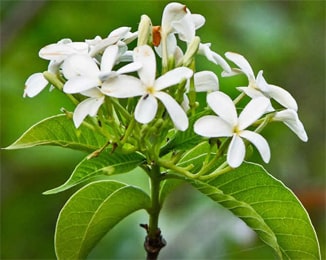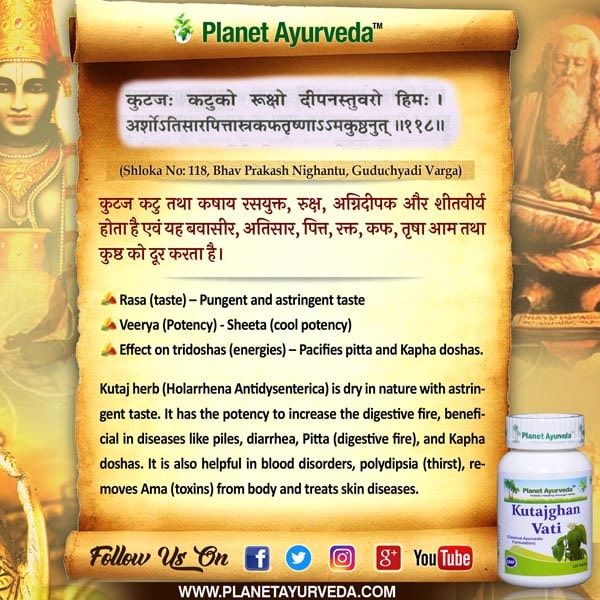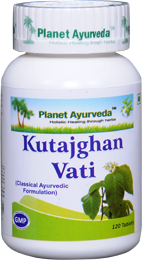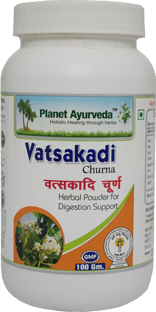Kutaja, Kurchi (Holarrhena antidysenterica) - Properties, Benefits & Dosage

Description of Plant
Kutaja (Holarrhena antidysenterica) is a glabrous tree or large shrub that is found throughout the deciduous forest areas of India at low elevations.
The leaves of this plant are 10-cm long and 4 to 10 cm broad opposite, oval and which are arranged in reverse directions and feel membranous.
Flowers can grows up to 2-3cm high and have five white petals. It has mild fragrance in corymbose cymes.
The fruits of this herb are paired and cylindrical in shape, dehiscing follicles hang out from the stalk.
Bark of the tree is rough, pale brownish or grayish in color.
Seeds are light brown having tufts of silky hair and are numerous in quantity.
If it get injured, the parts releases milk.
General Description
Kutaja is a prominent herb that manages the elevation of Kapha and pitta doshas. It is a very wonderful herb that is being used in treating diarrhea, irritable bowel syndrome etc. The bark, seeds, flowers and fruits are very useful for medicinal purposes.
The bark of therapeutic herb Kutaj consists of astringent, anthelmintic, amoebicidal and diuretic activities. Kutaja is one of the significant medicinal herb used with great property to treat amoebic dysentery and other gastric disorders.
Chemical Composition
In Bark - O-free alkaloids (conessine, conimine), conkurchine group alkaloids (including conessidine) and O-containing alkaloids (holarrhenine, holafrine, holarrhetine).
In leaves - Contains alkaloids (kurchiphyllamine and kurchiphylline).
Classification
- Kingdom - Plantae
- Order - Gentianales
- Family - Apocynaceae
- Genus - Wrightia
- Species - W. antidysenterica
Habitat
Geographically where it grows: Asian countries up to an altitude of 1300 m and also found throughout India. It is in abundance in sub-Himalayan tract in deciduous forests and open wastelands. It is common in tropical parts of India and in sub-Himalayan tract. Grows in the tropical Himalayas at an altitude of 1,100 meters and found in Travancore, Assam and Uttar Pradesh parts of India.
Names
- Sanskrit: Kutaja, Girimallikaa, Kaalinga, Kalingaka, Indravriksha, Shakra, Vatsa, Vatsaka,
- English Name - Kurchi, Conessi tree, conessi bark
- Hindi Name – Kuda, Kudaiya
- Punjabi Name - Kenara
- Common name - Country mallow, Heart-leaf
- Telugu Name - Kodisepala, Kodaga
- Tamil Name - Veppalai
- Bengali Name - Karachi, Kurachi
- Marathi Name - Kuda
- Gujarati Name - Kudo
- Kannada Name - Korachi
- Malayalam Name - Kodagapala
- Oriya Name - Kurei, Keruan
- Urdu Name - Kherva
Ayurvedic Properties
| Hindi / Sanskrit | English | ||
| Rasa | Tikta, Kashaya | Taste | Bitter, Astringent |
| Guna | Laghu, Rooksha | Physical Property | Light, Dryness |
| Virya | Sheeta | Potency | Cold |
| Vipaka | Katu | Metabolic Property (After Digestion) | Pungent |
Effects on Doshas
It balances pitta and Kapha doshas.
Classical Categorization
| Charak Samhita | Sushrut Samhita |
|
|
Ancient Verse about Holarrhena antidysenterica

The Bhavprakash nighantu edition of 1998 verse, 116-117 page no-346-349
The names of Kuda are Kutaja, Kutaj, Kit, Vatsaka, Girimallika, Kalinga, Shakshaki, indra, Yavphal, Virishak, and Panduindra which all are Sanskrit. It is astringent and bitter in taste and dry in nature. Promotes digestive fire and is cold in potency. It is good for piles, Diarrhea. Pitta and Kapha. Blood Disorders, cough and skin disorder.
References
The Bhavprakash nighantu with elaborated Hindi commentary by Padmashri prof. K.C. Chunekar, edited by Dr. G.S. Pandey: edition of 1998 verse 116-117, page no-346-349.
Properties and Practical Uses of Holarrhena antidysenterica
Properties
It is rich source of Antitubercular, Hypotensive, Antiprotozoal, Hypoglycaemic, Antispasmodic, Antigiardiastic, Antifungal, Antiamoeebiciadal, Antidiarrheal, Anticancer properties.
Practical Uses
It can be used both internally as well as externally. The medicinal uses of the plant are described below:
- Kutaja herb is very useful for the treatment of dysentery caused due to amoeba.
- It has ability to treat skin diseases like scabies, ringworm, itching and other infections.
- The seeds of this plant promote conception. Along with this these are used for toning up vaginal tissue after delivery in women.
- It is very suitable remedy for rheumatoid arthritis and osteoarthritis.
- This herb is a wonderful rejuvenating agent and also boosts the immune system of the body.
- Kutaja is useful remedy for the treatment of bleeding piles by keeping a check on the secretions of mucus and blood.
- A good herbal remedy in case of colic.
- It is also good to be used for mal-absorption.
- Very useful in treatment of urinary tract infection.
- Suitable and effective for disorder in the digestive system resulting vomiting.
- It is also used for children to kill worms in intestines since ancient days.
- Extract from the stem and bark benefits positively in mouth ulcer and also treats an oral infection.
Classical Reference

Part Used
- Bark
- Leaves
- Seeds
- Flowers
Dosage
- Seed powder: 2-4 g
- Decoction and infusion: 30-50 ml
- Tincture: 2-4 ml
- Powder: 2-4 g
Ayurvedic Product from Holarrhena antidysenterica by Planet Ayurveda
1. Kutza Ghan Vati
Kutaja is one of the ingredient of Product Kutza Ghan Vati which is good in Anti-dysentery and can treat severe diarrhea, ulcerative colitis and Irritable Bowel Syndrome.
2. Vatsakadi Churna
Kutaj is one of the ingredient of Product Vatsakadi churna which is useful for Crohn's disease and Ulcerative colitis.





